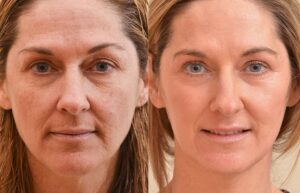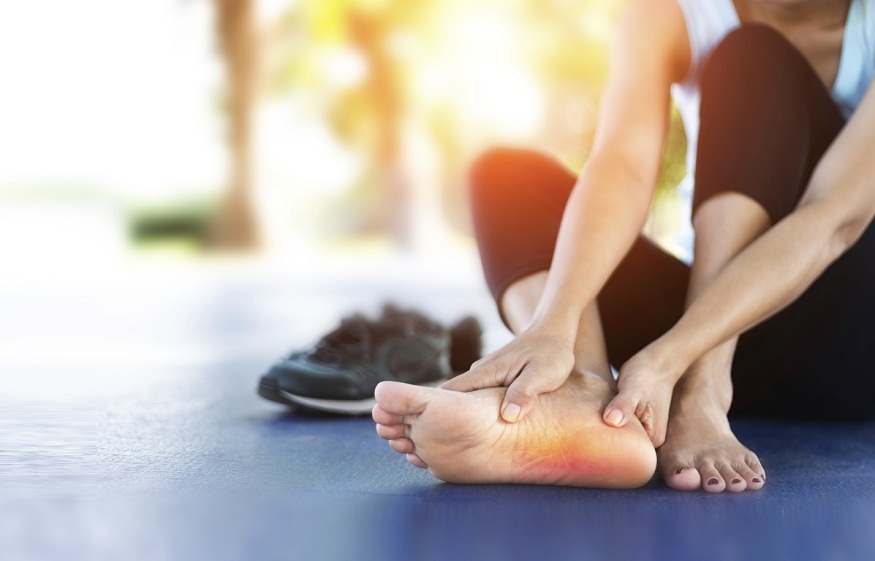Skin aging is due both to a component specific to each individual, called endogenous, and to sun exposure interacting with skin type, causing skin alterations grouped under the name helioderma.
This aging of the skin due to the sun is the cause of skin spots, a superficial pigmentary component, as well as a fragility of the small superficial vessels of the skin, a vascular component of helioderma . Finally, this helioderma can also be manifested by an alteration of the epidermis in the form of small crusts, solar keratoses, and a modification of the texture and flexibility of the dermis by alteration of the collagen and elastic fibers of the skin.
Endogenous aging, linked to the passage of time, is essentially manifested by slackening and loss of quality of the skin, with wrinkles, fine lines, and sometimes aging scabs, called seborrheic keratosis.
Laser rejuvenation or “photo-rejuvenation” consists of using light to improve and correct the texture of the skin, its pigmentation, vascular alterations.
These non-invasive or very minimally invasive techniques have been used for 20 years to act positively on the signs of skin aging, such as fine lines and wrinkles, brown spots, certain vascular lesions as well as slackening of the skin . The different treatment targets and the variety of devices that can be used require an initial diagnosis and expertise in the choice of treatments.
What areas can be rejuvenated with laser?
We can distinguish various areas of the face and body where wrinkles appear gradually and where the use of laser can be useful:
What lasers are used to rejuvenate?
From the most effective, invasive with social eviction addressing severe aging with very wrinkled skin to the lightest techniques addressing the superficial components; there are various solutions to rejuvenate:
Ablative fractional lasers (co2) to remove wrinkles
These lasers offer excellent results in terms of rejuvenation but induce social eviction 10 to 15 days after the session. The skin is renewed on the surface all over the face. The patient should expect relatively significant transient effects: dermabrasion causing bleeding and the formation of scabs. The risks mentioned are often due to improper use of the laser doctor. Expertise must be required for the use of this type of laser.
Non-ablative fractional lasers to reduce wrinkles
Fractional non-ablative lasers (so-called resurfacing) act deeply and gradually in the skin tissues. Micro-channels created during the sessions allow the gradual renewal of the skin. The secondary consequences are simple (redness, edema) and do not induce social eviction. These lasers can be used both to prevent aging and to correct existing wrinkles and fine lines.
They thus offer excellent results in the management of wrinkles around the eyes by relaunching the synthesis of collagen.
Leds for rejuvenation
LEDs act by non-thermal mechanisms (unlike lasers). These devices are intended to stimulate the cells of our skin. They can improve the quality of the skin , act on certain pigment spots and are sometimes used to reduce the risk of appearance of brown spots (inherent in any inflammatory process) after a laser session or a peeling. To remove wrinkles , we prefer lasers instead.
Pulsed lights
They are rarely used for the management of wrinkles or fine lines . Like LEDs, pulsed light machines will improve the overall quality of the skin. They will thus make it possible to attenuate the brown spots associated with aging.
Treat sagging skin
Sagging skin is also a stigma of aging. It is inevitable, over time, the structure of the skin changes, deteriorates, it produces less collagen and elastin and gradually relaxes. While lasers can help in the production of collagen, certain energy-based techniques are particularly indicated for the management of sagging skin.
High Intensity Focused Ultrasound for Sagging Skin (HIFU)
High Intensity Focused Ultrasounds or HIFU (High Intensity Focused Ultrasounds) devices hold a place of choice in non-invasive rejuvenation treatments. The ultrasounds will induce, thanks to the creation of micro-points of coagulation in the layers of the skin, a re-tensioning of the skin. The goal is to initiate a gradual process of cell regeneration.
Focused ultrasound is particularly beneficial for people with moderate sagging in the face and neck . They thus offer excellent results at the level of the jowls, the oval of the face which has become blurred with age, but also drooping eyelids.
Its indications on the body are limited, but they can sometimes be used on the arms and neckline. The treatment is not very comfortable, hands does not induce social eviction. Ultrasounds have the advantage of being feasible on all skin phototypes.
Radiofrequency for sagging skin
It is one of the oldest non-invasive techniques for treating sagging skin . By contracting and heating the fibers of the skin, the radiofrequency will stimulate the production of collagen and elastin to gradually tighten it.
Used on the face or the body, it also offers very good results, but it is necessary, unlike focused ultrasound, to perform several sessions. Without social eviction, radiofrequency sessions also have the advantage of being able to be carried out all year round (no contraindications with sun exposure) and on all skin phototypes.
In conclusion
Skin rejuvenation involves various techniques: injections, laser, radio frequency, ultrasound, to correct the signs of skin aging. These techniques, which can be used in synergy, have demonstrated their effectiveness and harmlessness, even if they will never replace surgery.
The prices obviously vary according to the indications, the devices used as well as the surface to be treated, from a few hundred euros per session (for lasers and radiofrequency) to 2,500 euros for rejuvenation treatments using focused ultrasound, for example.
Prior consultation with your dermatologist or laser doctor is essential, it allows you to develop a personalized treatment protocol after a clinical examination of the areas to be rejuvenated, and the indications (wrinkles, fine lines, sagging skin, spots, etc.).




